高中英语听说课教学设计
- 格式:doc
- 大小:19.00 KB
- 文档页数:5
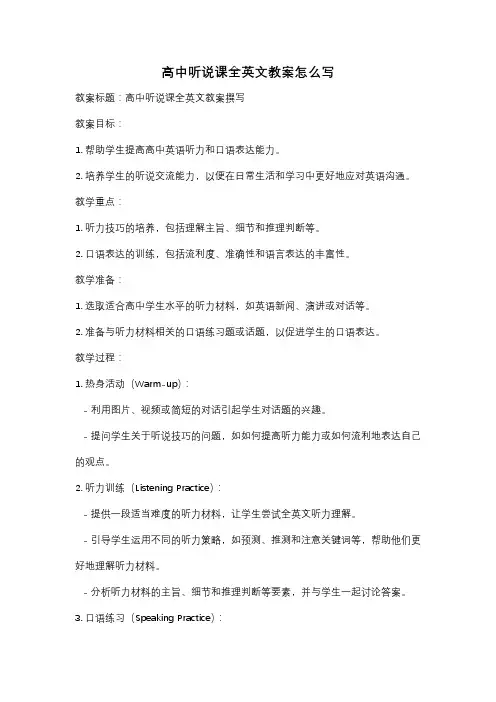
高中听说课全英文教案怎么写教案标题:高中听说课全英文教案撰写教案目标:1. 帮助学生提高高中英语听力和口语表达能力。
2. 培养学生的听说交流能力,以便在日常生活和学习中更好地应对英语沟通。
教学重点:1. 听力技巧的培养,包括理解主旨、细节和推理判断等。
2. 口语表达的训练,包括流利度、准确性和语言表达的丰富性。
教学准备:1. 选取适合高中学生水平的听力材料,如英语新闻、演讲或对话等。
2. 准备与听力材料相关的口语练习题或话题,以促进学生的口语表达。
教学过程:1. 热身活动(Warm-up):- 利用图片、视频或简短的对话引起学生对话题的兴趣。
- 提问学生关于听说技巧的问题,如如何提高听力能力或如何流利地表达自己的观点。
2. 听力训练(Listening Practice):- 提供一段适当难度的听力材料,让学生尝试全英文听力理解。
- 引导学生运用不同的听力策略,如预测、推测和注意关键词等,帮助他们更好地理解听力材料。
- 分析听力材料的主旨、细节和推理判断等要素,并与学生一起讨论答案。
3. 口语练习(Speaking Practice):- 提供与听力材料相关的口语练习题或话题,鼓励学生运用所学知识进行口语表达。
- 在小组或整体讨论的形式下,让学生分享自己的观点、经验或意见,并鼓励他们互相交流和提问。
- 提供语言表达的反馈和指导,帮助学生改进口语表达的准确性、流利度和语言表达的丰富性。
4. 结束活动(Wrap-up):- 总结本堂课的学习内容,强调学生在听说方面的进步和提高。
- 鼓励学生继续进行听说练习,并提供相关的学习资源或建议。
教学延伸:1. 鼓励学生在课后进行更多的听力练习,如听英语新闻、音乐或英语播客等。
2. 提供学生参与英语角或英语辩论等口语实践的机会,以提高他们的口语表达能力。
3. 推荐学生使用在线学习平台或语言学习应用程序,如BBC Learning English、Duolingo等,以增强他们的听说技能。
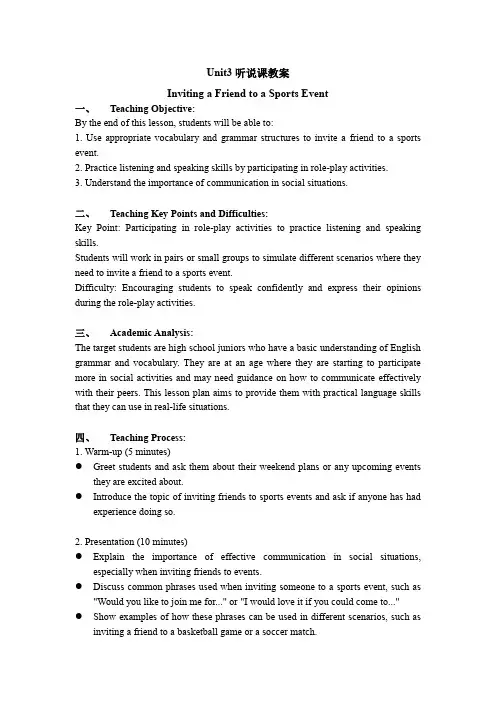
Unit3听说课教案Inviting a Friend to a Sports Event一、Teaching Objective:By the end of this lesson, students will be able to:1. Use appropriate vocabulary and grammar structures to invite a friend to a sports event.2. Practice listening and speaking skills by participating in role-play activities.3. Understand the importance of communication in social situations.二、Teaching Key Points and Difficulties:Key Point: Participating in role-play activities to practice listening and speaking skills.Students will work in pairs or small groups to simulate different scenarios where they need to invite a friend to a sports event.Difficulty: Encouraging students to speak confidently and express their opinions during the role-play activities.三、Academic Analysis:The target students are high school juniors who have a basic understanding of English grammar and vocabulary. They are at an age where they are starting to participate more in social activities and may need guidance on how to communicate effectively with their peers. This lesson plan aims to provide them with practical language skills that they can use in real-life situations.四、Teaching Process:1. Warm-up (5 minutes)●Greet students and ask them about their weekend plans or any upcoming eventsthey are excited about.●Introduce the topic of inviting friends to sports events and ask if anyone has hadexperience doing so.2. Presentation (10 minutes)●Explain the importance of effective communication in social situations,especially when inviting friends to events.●Discuss common phrases used when inviting someone to a sports event, such as"Would you like to join me for..." or "I would love it if you could come to..."●Show examples of how these phrases can be used in different scenarios, such asinviting a friend to a basketball game or a soccer match.3. Practice (15 minutes)●Divide students into pairs or small groups and give each group a set of scenariocards with different ways of inviting a friend to a sports event.●Ask students to role-play the scenarios using the phrases they learned in thepresentation, making sure to encourage them to speak confidently and express their opinions.●After each pair or group has finished their role-play, ask for feedback from therest of the class on their performance and offer suggestions for improvement.4. Production (10 minutes)●Have one student from each pair or group present their role-play to the class,focusing on their use of language and expressions learned in the lesson.●Assess their performance based on factors such as pronunciation, grammaraccuracy, and confidence in speaking.5. Consolidation (5 minutes)●Review the key points and difficulties of the lesson, encouraging students toreflect on what they learned and how they can apply it in their daily lives.●Encourage students to continue practicing their English skills outside of class byinviting friends to other events, such as movie nights or dinner dates.。
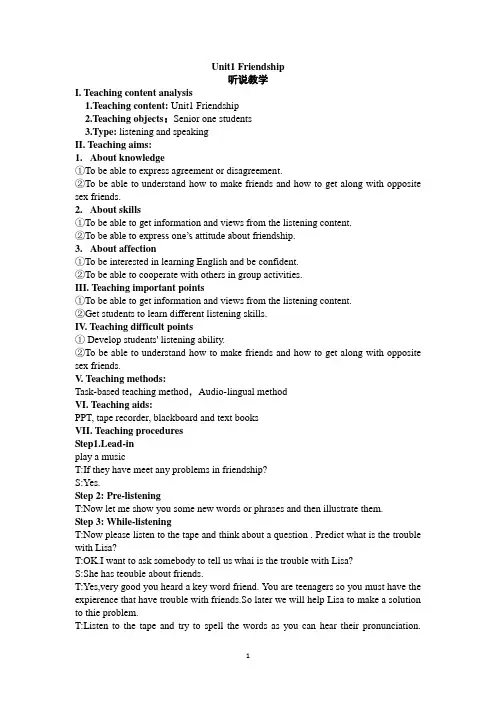
Unit1 Friendship听说教学I. Teaching content analysis1.Teaching content: Unit1 Friendship2.Teaching objects:Senior one students3.Type: listening and speakingII. Teaching aims:1.About knowledge①To be able to express agreement or disagreement.②To be able to understand how to make friends and how to get along with opposite sex friends.2.About skills①To be able to get information and views from the listening content.②To be able to express one’s attitude about friendship.3.About affection①To be interested in learning English and be confident.②To be able to cooperate with others in group activities.III. Teaching important points①To be able to get information and views from the listening content.②Get students to learn different listening skills.IV. Teaching difficult points① Develop students' listening ability.②To be able to understand how to make friends and how to get along with opposite sex friends.V. Teaching methods:Task-based teaching method,Audio-lingual methodVI. Teaching aids:PPT, tape recorder, blackboard and text booksVII. Teaching proceduresStep1.Lead-inplay a musicT:If they have meet any problems in friendship?S:Yes.Step 2: Pre-listeningT:Now let me show you some new words or phrases and then illustrate them.Step 3: While-listeningT:Now please listen to the tape and think about a question . Predict what is the trouble with Lisa?T:OK.I want to ask somebody to tell us whai is the trouble with Lisa?S:She has teouble about friends.T:Yes,very good you heard a key word friend. You are teenagers so you must have the expierence that have trouble with friends.So later we will help Lisa to make a solution to thie problem.T:Listen to the tape and try to spell the words as you can hear their pronunciation.Then write your answers about the blank place on the paper. (on PPT).(After the first listening)S:(Answer the questions.)T:OK, stop. Let’s share the answers. Well done.T:Now, please Listen to the tape again and use the exercise above to help you answer the following questions (on PPT).1.What does Miss Wang say about their friendship?She says that__________________________________________2.Why doesn’t she think that Lisa should end their friendship?She thinks that __________________________________________3.How does she e xplain why Lisa’s classmates gossip about their friendship?She says that __________________________________________4.What is Miss Wang’s advice?She asks Lisa to __________________________________________S:(Answer the questions.)(After the second listening)T:Now let us listen again with seeing the text on PPT,OK? Please pay attention to the details and the character.(After the third listening)T:OK, now you can see the text clearly and we’ve already known the details.Step 4: Post-listeningT:Now let me show you some new words ,phrases and sentences which may be used T:OK. I will ask some students to work in pair and role-play, and discuss the following questions.(on PPT)T:Group1.please stand up!T:Do you think that it is a good idea for Lisa to keep silent about the gossip?S:Yes, because...T:Now let us have a competition. Look at the PPT. And i will divide you into 8 groups and then you should consider the questions on the PPT.T :Well done! Some of you are good at speech and discussion! So today is enouggh ,I hope you can be better next time !Step5.SummaryTell students the tips of listening tasks.Ask two students to summary this lesson and talk about their feelings.Step 6.Homework1.Finish the exercise in the exercise book.2.Talk about your experience in your lifeVII. The layout of the blackboard。
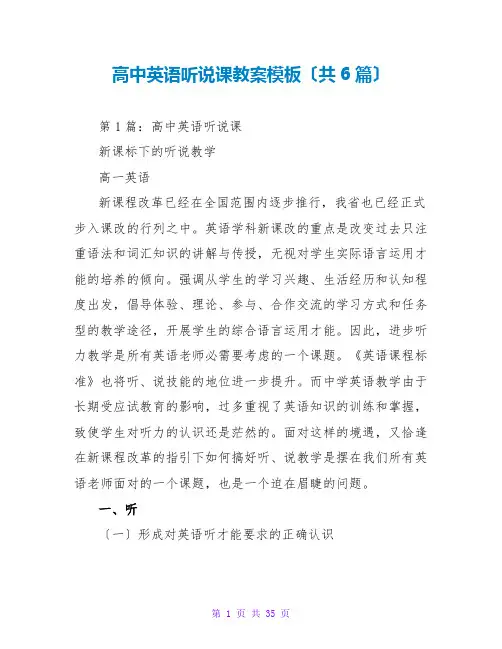
高中英语听说课教案模板〔共6篇〕第1篇:高中英语听说课新课标下的听说教学高一英语新课程改革已经在全国范围内逐步推行,我省也已经正式步入课改的行列之中。
英语学科新课改的重点是改变过去只注重语法和词汇知识的讲解与传授,无视对学生实际语言运用才能的培养的倾向。
强调从学生的学习兴趣、生活经历和认知程度出发,倡导体验、理论、参与、合作交流的学习方式和任务型的教学途径,开展学生的综合语言运用才能。
因此,进步听力教学是所有英语老师必需要考虑的一个课题。
《英语课程标准》也将听、说技能的地位进一步提升。
而中学英语教学由于长期受应试教育的影响,过多重视了英语知识的训练和掌握,致使学生对听力的认识还是茫然的。
面对这样的境遇,又恰逢在新课程改革的指引下如何搞好听、说教学是摆在我们所有英语老师面对的一个课题,也是一个迫在眉睫的问题。
一、听〔一〕形成对英语听才能要求的正确认识新课标逐年加大听力局部的分值。
目前,英语口试还不作一般考试的要求,所以,学生不会创造气氛去说英语。
基于这种情况,我们应努力让学生理解,好的听力不仅对笔试有帮助,它更是一种才能的表达,因为我们学英语的目的不是为了考试,考试是作为一种催促的手段,我们的目的是用英语来进展交际。
口头交流是最简单最普遍的交际方式。
而只有我们在听得懂别人说的话和说得出自己的观点时,我们才有交流。
所以说,听懂说好英语既是我们学习的目的,也是学习英语的根本要求。
〔二〕听前准备听前的准备工作是非常重要的,一般情况下老师只是留几分钟时间让学生自己看要答复的问题,或在多媒体课件上列出一些听力内容中的生词、词组后就让学生听了。
听完后直接对答案。
但对于那些内容较难的听力材料,我们除了做以上工作外还应该给学生讲解一些关于听力材料的背景知识,把它当作听前的热身。
可以先让学生们看问题和与它相对应的选项,在他们看完以后,我让他们猜想听力材料的大致内容。
多数同学猜不出来,少数能猜出来的同学也不敢答复。
这时可以在黑板上列出了以下一些【关键词】:^p 。
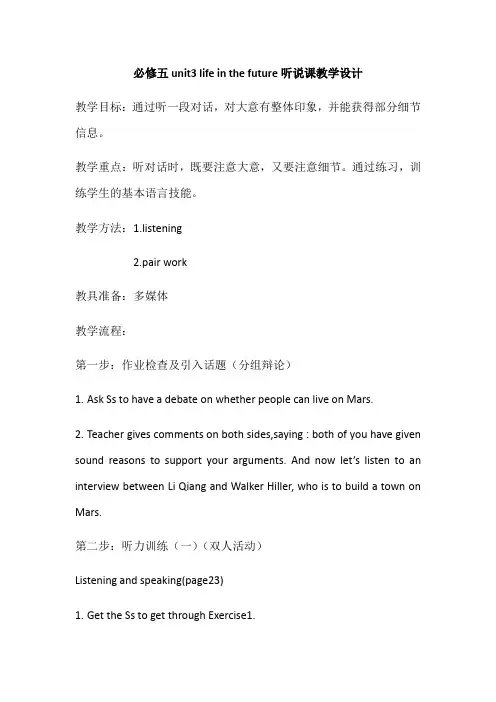
必修五unit3 life in the future听说课教学设计教学目标:通过听一段对话,对大意有整体印象,并能获得部分细节信息。
教学重点:听对话时,既要注意大意,又要注意细节。
通过练习,训练学生的基本语言技能。
教学方法:1.listening2.pair work教具准备:多媒体教学流程:第一步:作业检查及引入话题(分组辩论)1.Ask Ss to have a debate on whether people can live on Mars.2.Teacher gives comments on both sides,saying : both of you have given sound reasons to support your arguments. And now let’s listen to an interview between Li Qiang and Walker Hiller, who is to build a town on Mars.第二步:听力训练(一)(双人活动)Listening and speaking(page23)1.Get the Ss to get through Exercise1.2.First, listen for the Ss to finish Exercise13.Second,listen for the Ss to finish Exercise24.Third,listen for the Ss to put down the question in it that are used to make predictions.Can you imagine how that’ll be achieved?Is it likely that you can find and use water?I wonder if...?How health will the people be, I wonder?5.Get the Ss to exchange their information to correct their answers?第三步:口语活动1.(pair work)Ask Ss to list some questions about what life will be like in you hometown in 1000 years’time, using the expressions above to help them.2.(pair work) InterviewSituation : Suppose you’re in a newly-elected major, and now is being interviewed on TV. The host is raising some questions on your plan for the coming five years.Have the Ss to make up the interview in pairs, trying to use theexpressions above.第四步:听力训练(二)(双人活动)Listening task(page55)1.Ss read the phrases before listening to the tape.2.Listen to the tape and finish Exercise1第五步:口语训练(二)广告词设计大赛1.Ask the Ss to have a look at the requirements in the “taking part”2.3.Let them choose of the three as they like and work in groups of four and design the text of an ad for the product.4.Ask Ss to read their texts to the class, and Ss vote for their favorite.5.6.Count the result to see which group get the most votes.7.8.Teacher may give an award to the winners.第六步:布置作业Ask the Ss to go over what they learned in the class according to the “Summing up” on page 24.教学反思:这一节听说课的教学设计,从听前的问题预测,到听后的问题回答,都与利于学生的听力培养和口语表达,是学生在听说过程中逐步提高英语运用能力。
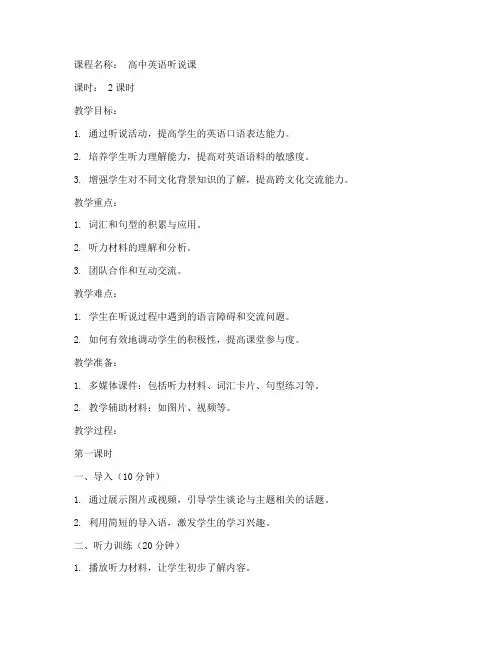
课程名称:高中英语听说课课时: 2课时教学目标:1. 通过听说活动,提高学生的英语口语表达能力。
2. 培养学生听力理解能力,提高对英语语料的敏感度。
3. 增强学生对不同文化背景知识的了解,提高跨文化交流能力。
教学重点:1. 词汇和句型的积累与应用。
2. 听力材料的理解和分析。
3. 团队合作和互动交流。
教学难点:1. 学生在听说过程中遇到的语言障碍和交流问题。
2. 如何有效地调动学生的积极性,提高课堂参与度。
教学准备:1. 多媒体课件:包括听力材料、词汇卡片、句型练习等。
2. 教学辅助材料:如图片、视频等。
教学过程:第一课时一、导入(10分钟)1. 通过展示图片或视频,引导学生谈论与主题相关的话题。
2. 利用简短的导入语,激发学生的学习兴趣。
二、听力训练(20分钟)1. 播放听力材料,让学生初步了解内容。
2. 引导学生听细节,回答问题。
3. 分组讨论,分享听力感受和观点。
三、词汇和句型练习(15分钟)1. 教师带领学生总结听力材料中的重点词汇和句型。
2. 学生进行小组练习,运用所学词汇和句型进行对话。
四、小组活动(20分钟)1. 学生分组,根据所学内容进行角色扮演。
2. 鼓励学生发挥创意,展示自己的英语口语能力。
五、总结(5分钟)1. 教师总结本节课的重点内容。
2. 学生分享学习心得,提出疑问。
第二课时一、复习(10分钟)1. 回顾上一节课的内容,检查学生的学习情况。
2. 学生进行口语练习,巩固所学知识。
二、听力训练(20分钟)1. 播放新的听力材料,提高学生的听力水平。
2. 学生完成听力练习,教师点评。
三、口语表达(15分钟)1. 学生根据所学内容,进行口语表达练习。
2. 教师给予指导和鼓励。
四、小组讨论(20分钟)1. 学生分组,就某一话题进行讨论。
2. 鼓励学生积极参与,发表自己的观点。
五、总结(5分钟)1. 教师总结本节课的重点内容。
2. 学生分享学习心得,提出疑问。
教学反思:1. 教师应关注学生的个体差异,因材施教。

高中英语听说课教案及反思一、教学目标1. 语言知识目标:(1)能够听懂、会说、会读、会写以下句子:He is a good student.He studies hard.(2)能够听懂、会说、会读、会写以下单词:Good, student, hard2. 情感态度价值观目标:通过本节课的学习,学生能够体会到学习的重要性,学会珍惜学习的机会,努力学习,取得更好的成绩。
二、教学重点1. 能够听懂、会说、会读、会写以下句子:He is a good student.He studies hard.2. 能够听懂、会说、会读、会写以下单词:Good, student, hard三、教学准备1. 教学用书:高中英语课本2. 教学器材:录音机、多媒体3. 教学过程(1)Warm-up1. Greeting2. Free talk(2)Lead-in1. Show some pictures about students studying hard.2. Ask students to talk about the pictures.(3)Pre-listening1. Ask students to look at the pictures and guess what the dialogue is about.2. Ask students to make a prediction about the dialogue.(4)While-listening1. Play the recording for students to listen.2. Ask students to listen and answer the questions.(5)Post-listening1. Ask students to discuss the dialogue in pairs.2. Ask students to summarize the dialogue.(6)Consolidation1. Ask students to practice the dialogue in pairs.2. Ask students to write a short passage about the dialogue.四、教学反思本节课的教学内容是高中英语听说课,我采用了多媒体辅助教学的方法,让学生在轻松愉快的氛围中学习,学生们也表现出了很大的积极性,他们都能够听懂、会说、会读、会写以下句子和单词,并且能够熟练的运用这些句子和单词,这让我感到很欣慰。
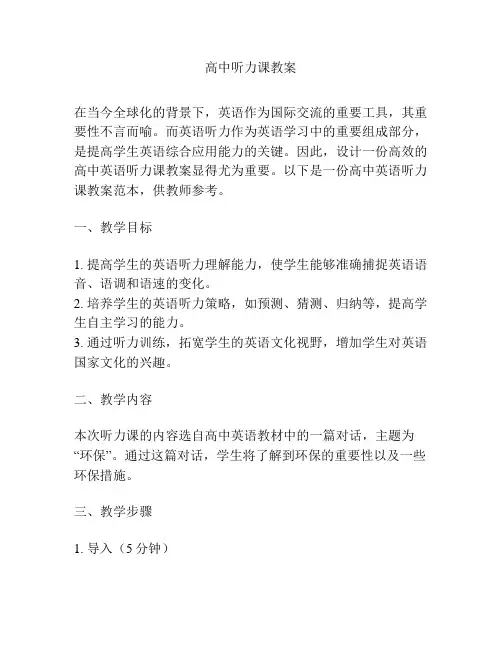
高中听力课教案在当今全球化的背景下,英语作为国际交流的重要工具,其重要性不言而喻。
而英语听力作为英语学习中的重要组成部分,是提高学生英语综合应用能力的关键。
因此,设计一份高效的高中英语听力课教案显得尤为重要。
以下是一份高中英语听力课教案范本,供教师参考。
一、教学目标1. 提高学生的英语听力理解能力,使学生能够准确捕捉英语语音、语调和语速的变化。
2. 培养学生的英语听力策略,如预测、猜测、归纳等,提高学生自主学习的能力。
3. 通过听力训练,拓宽学生的英语文化视野,增加学生对英语国家文化的兴趣。
二、教学内容本次听力课的内容选自高中英语教材中的一篇对话,主题为“环保”。
通过这篇对话,学生将了解到环保的重要性以及一些环保措施。
三、教学步骤1. 导入(5分钟)教师通过展示一些关于环境污染的图片,引起学生对环保话题的关注。
同时,教师可以简单介绍一些环保知识,为接下来的听力内容做铺垫。
2. 听力训练(15分钟)(1)教师播放对话录音,学生先整体感受对话内容。
(2)教师分段播放录音,每段播放后,学生回答相关问题,以检验学生对对话内容的理解程度。
(3)教师再次播放整篇对话,学生跟读,注意模仿语音、语调和语速。
3. 听力策略讲解(10分钟)教师结合对话内容,讲解如何运用预测、猜测、归纳等策略进行听力训练。
例如,在听对话前,学生可以根据题目预测对话内容;在听对话过程中,学生可以根据已听到的信息猜测接下来的对话内容;听完对话后,学生可以归纳总结对话的主题和要点。
4. 拓展活动(10分钟)教师组织学生进行小组讨论,让学生分享自己在日常生活中如何实践环保,以及如何向他人宣传环保意识。
通过这个活动,学生可以运用所学的英语知识进行实际交流,提高英语听说能力。
四、教学反思通过本次听力课的教学,教师需要对学生的学习情况进行总结和反思。
教师可以关注以下几个方面:1. 学生的听力理解能力是否有所提高?2. 学生是否能够熟练运用听力策略进行听力训练?3. 学生在拓展活动中的表现如何?是否能积极参与讨论和分享?总之,高中英语听力课教案的设计需要充分考虑学生的实际需求,注重培养学生的听力理解能力和自主学习能力。
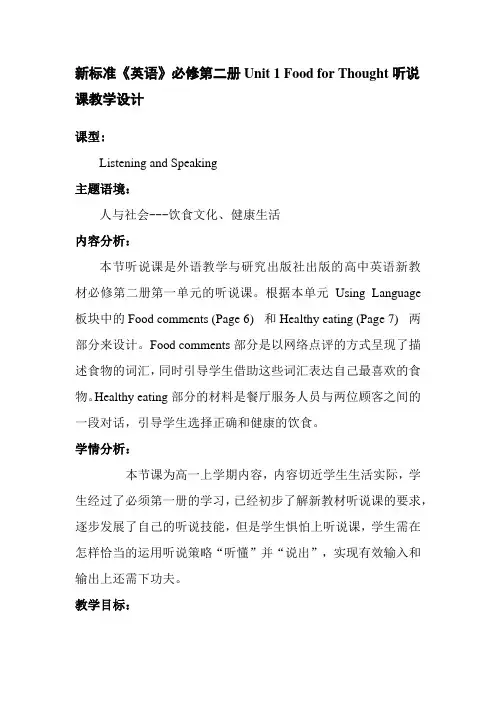
新标准《英语》必修第二册Unit 1 Food for Thought听说课教学设计课型:Listening and Speaking主题语境:人与社会---饮食文化、健康生活内容分析:本节听说课是外语教学与研究出版社出版的高中英语新教材必修第二册第一单元的听说课。
根据本单元Using Language 板块中的Food comments (Page 6)和Healthy eating (Page 7)两部分来设计。
Food comments部分是以网络点评的方式呈现了描述食物的词汇,同时引导学生借助这些词汇表达自己最喜欢的食物。
Healthy eating部分的材料是餐厅服务人员与两位顾客之间的一段对话,引导学生选择正确和健康的饮食。
学情分析:本节课为高一上学期内容,内容切近学生生活实际,学生经过了必须第一册的学习,已经初步了解新教材听说课的要求,逐步发展了自己的听说技能,但是学生惧怕上听说课,学生需在怎样恰当的运用听说策略“听懂”并“说出”,实现有效输入和输出上还需下功夫。
教学目标:1.学生能够掌握描述食物的色香味等特征的形容词并能恰当使用这些形容词来描述食物。
2.学生能够根据具体语境选择合适的语言给对方提出合理化的饮食建议。
3.学生能听懂与点菜有关的对话,讨论并加深对健康饮食的认识。
学生能够了解健康饮食的相关知识,增强健康饮食的意识;反思和改进自己的饮食习惯,并能够在生活中去落实。
教学重点:1.引导学生用学过的词汇和结构介绍自己喜欢的食物。
2.引导学生获取对话中关于健康饮食的相关信息,并进行归纳,根据语境进行语言输出。
教学难点:引导学生提取并总结提出建议的表达,并迁移和运用于相似的情景交流中。
教学策略:交际法教学法、任务型教学法、听说教学法Teaching procedures:Lead - inTeacher’s activityThe teacher invites the students to talk about blue cheese and stinky Tofu in the passage A Child of Two Cuisines using words they consider appropriate.Students’ activityThe students talk about the food and try to realize they can talk about the food from different aspects.The purposeHave the students know they can talk about certain food from different aspects.Activity 1Teacher’s activi tyThe teacher asks the students to read the comments on the left and match the comments to the pictures.Students’ activityThe students read the comments and match them to the pictures.The purposeHave the students understand the topic-related words in a real context.Activity 2Teacher’s activity1. The teacher asks the students to read the comments again and underline the words that describe food.2. The teacher asks the students to put the underlined words into the correct columns of the table and add more similar words. Students’ activity1. The students read the comments again and underline the words.2. The students put the words into the table accordingly and add more similar ones.The purposeHave the students categorise the words describing different food. Activity 3Teacher’s activityThe teacher asks the students to talk about their favourite food in pairs, using the words they have learnt.Students’ activityThe students talk about their favourite food in pairs, using as many words they have learnt as possible.The purposeGet the students to use the words in a real-life context.Activity 4Teacher’s activityThe teacher asks the students to look at the pictures and listen to the conversation. Then asks the students to tick the food and drinks ordered.Students’ activityThe students listen for the first time, and tick the food and drinks ordered.The purposeHave the students learn to understand the main idea of the listening material.Activity 5Teacher’s activity1. The teacher gets the students to listen to the conversation again and complete the notes. Have the students listen again if necessary.2. The teacher then asks the students to talk about what Harriet says to persuade Janet.Students’ activity1. The students listen to the conversation and complete the notes.2. The students then talk about what Harriet says to persuade Janet. The purpose1. Have the students learn to understand the details of the listening material.2. Have the students learn the way of giving advice.Activity 6Teacher’s activity1. The teacher asks the students to work in pairs, turn to the corresponding pages and read the information.2. The teacher asks the students to act out the conversation to persuade a customer. The teacher provides help to the students when necessary.3. The teacher invites some pairs to act out the conversation in class. Students’ activity1. The students work in pairs and read the information on the corresponding pages.2. The students act out the conversation in pairs.The purposeHave the students practise giving advice in the fixed scene.Activity 6Teacher’s activityThe teacher asks the students to think of a similar situation and have a conversation to persuade others. Provide help to the students when necessary.Students’ activityThe students think about another situation and have a similar conversation.The purposeHave the students practise giving advice in a topic-related real-life context.HomeworkTeacher’s activityThe teacher asks the students to carry out a survey with group members after class to make a list of the healthy food in life and decide one to recommend it to their friends, giving brief description about it.Students’ activityThe students carry out a survey with group members after class to make a list of the healthy food in life and decide one to recommend it to their friends, giving brief description about it.The purposeHave the students better understand our main topic in real life.教后反思:本节课是第四届齐鲁名师建设工程人选“山东省英语学科新高考研讨会”上的一节展示课。
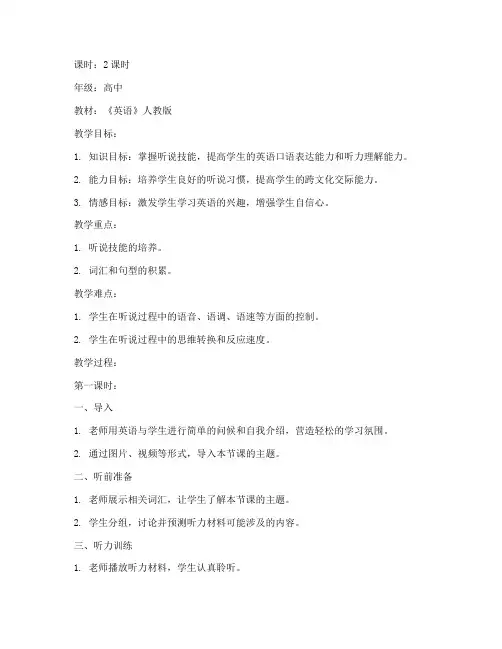
课时:2课时年级:高中教材:《英语》人教版教学目标:1. 知识目标:掌握听说技能,提高学生的英语口语表达能力和听力理解能力。
2. 能力目标:培养学生良好的听说习惯,提高学生的跨文化交际能力。
3. 情感目标:激发学生学习英语的兴趣,增强学生自信心。
教学重点:1. 听说技能的培养。
2. 词汇和句型的积累。
教学难点:1. 学生在听说过程中的语音、语调、语速等方面的控制。
2. 学生在听说过程中的思维转换和反应速度。
教学过程:第一课时:一、导入1. 老师用英语与学生进行简单的问候和自我介绍,营造轻松的学习氛围。
2. 通过图片、视频等形式,导入本节课的主题。
二、听前准备1. 老师展示相关词汇,让学生了解本节课的主题。
2. 学生分组,讨论并预测听力材料可能涉及的内容。
三、听力训练1. 老师播放听力材料,学生认真聆听。
2. 学生回答听力问题,老师点评并纠正错误。
四、口语练习1. 学生根据听力材料,进行角色扮演或小组讨论。
2. 老师鼓励学生大胆开口,注意语音、语调、语速等方面的控制。
五、总结与反思1. 老师对本节课的学习内容进行总结,强调重点和难点。
2. 学生分享学习心得,互相鼓励。
第二课时:一、复习1. 老师检查学生第一节课的学习情况,提问相关知识点。
2. 学生互相纠正错误,巩固所学知识。
二、听力训练1. 老师播放新的听力材料,学生认真聆听。
2. 学生回答听力问题,老师点评并纠正错误。
三、口语练习1. 学生根据听力材料,进行角色扮演或小组讨论。
2. 老师鼓励学生大胆开口,注意语音、语调、语速等方面的控制。
四、拓展活动1. 老师展示与本节课主题相关的图片或视频,引导学生进行讨论。
2. 学生分享自己的观点,提高跨文化交际能力。
五、总结与反思1. 老师对本节课的学习内容进行总结,强调重点和难点。
2. 学生分享学习心得,互相鼓励。
教学评价:1. 学生在听说过程中的参与度和积极性。
2. 学生对听力材料的理解和掌握程度。
3. 学生口语表达的能力和准确性。
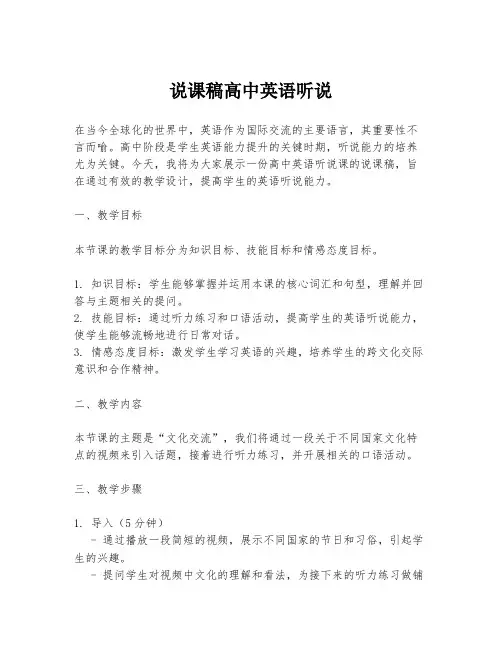
说课稿高中英语听说在当今全球化的世界中,英语作为国际交流的主要语言,其重要性不言而喻。
高中阶段是学生英语能力提升的关键时期,听说能力的培养尤为关键。
今天,我将为大家展示一份高中英语听说课的说课稿,旨在通过有效的教学设计,提高学生的英语听说能力。
一、教学目标本节课的教学目标分为知识目标、技能目标和情感态度目标。
1. 知识目标:学生能够掌握并运用本课的核心词汇和句型,理解并回答与主题相关的提问。
2. 技能目标:通过听力练习和口语活动,提高学生的英语听说能力,使学生能够流畅地进行日常对话。
3. 情感态度目标:激发学生学习英语的兴趣,培养学生的跨文化交际意识和合作精神。
二、教学内容本节课的主题是“文化交流”,我们将通过一段关于不同国家文化特点的视频来引入话题,接着进行听力练习,并开展相关的口语活动。
三、教学步骤1. 导入(5分钟)- 通过播放一段简短的视频,展示不同国家的节日和习俗,引起学生的兴趣。
- 提问学生对视频中文化的理解和看法,为接下来的听力练习做铺垫。
2. 听力练习(15分钟)- 播放一段与“文化交流”相关的听力材料,学生需要集中注意力,理解大意。
- 学生听后回答教师提出的问题,检验学生的理解程度。
- 分组讨论听力材料中的关键信息,并准备简短的口头报告。
3. 口语活动(20分钟)- 学生分组,每组选择一个国家的文化特色进行介绍。
- 每组准备并进行角色扮演,模拟文化交流的场景。
- 其他小组成员提问,进行互动,教师适时给予指导和帮助。
4. 总结与反馈(10分钟)- 邀请几组学生展示他们的口语活动成果。
- 教师总结本节课的重点内容,强调听说技巧的重要性。
- 学生提出自己在听说过程中遇到的问题,教师给予解答和建议。
四、教学评价1. 过程评价:教师在课堂上观察学生的参与情况,及时给予反馈,鼓励学生积极发言。
2. 结果评价:通过听力练习和口语活动的表现,评估学生对教学内容的掌握程度。
3. 反馈评价:课后通过作业和小测验,进一步巩固学生的学习成果,并为下一节课做准备。
高中英语听说课的教学设计一、教学任务及对象1、教学任务本节课的教学任务是基于高中英语课程标准,针对英语听说技能进行的教学设计。
通过本节课的学习,学生能够提高英语听力理解能力,掌握日常交流中的口语表达技巧,培养用英语进行有效沟通的能力。
教学内容主要包括:听力材料的理解、口语表达的准确性、流利性以及交流策略的运用。
2、教学对象本节课的教学对象为高中一年级学生,他们已经具备了一定的英语基础,能够进行简单的英语听说交流。
然而,大部分学生在英语听说方面仍存在困难,如听力理解不准确、口语表达不流利等。
因此,本节课将针对这些问题进行有针对性的教学设计,帮助学生在英语听说方面取得进步。
同时,考虑到学生的个体差异,教学过程中将注重分层教学,确保每个学生都能在课堂上得到锻炼和提升。
二、教学目标1、知识与技能(1)理解并掌握听力材料中的关键信息,如人物、地点、时间、事件等。
(2)学会运用不同的口语表达方式,如描述、比较、解释等,进行有效沟通。
(3)提高英语听说过程中的信息筛选、归纳、总结能力。
(4)掌握一定的听说策略,如预测、关键词查找、语速适应等。
(5)能够在实际情境中运用所学知识,进行流畅的英语听说交流。
2、过程与方法(1)采用任务型教学法,以学生为主体,让学生在完成具体任务的过程中,培养英语听说能力。
(2)运用情景教学,创设真实的语言环境,激发学生的学习兴趣和积极性。
(3)利用多媒体教学资源,如视频、音频、图片等,丰富教学内容,提高教学效果。
(4)开展小组合作学习,培养学生的团队协作能力和自主学习能力。
(5)实施个性化教学,关注学生的个体差异,满足不同学生的学习需求。
3、情感,态度与价值观(1)培养学生对英语听说学习的兴趣和热情,提高学习积极性。
(2)帮助学生树立自信心,勇于在课堂上展示自己的英语听说能力。
(3)引导学生正确对待英语学习中的困难和挫折,培养克服困难的意志力。
(4)培养学生的跨文化交际意识,尊重和理解不同文化背景下的交流方式。
英语听说课教学设计〔共4篇〕第1篇:高中英语听说课教学设计必修五unit3 life in the future听说课教学设计教学目的:通过听一段对话,对大意有整体印象,并能获得局部细节信息。
教学重点:听对话时,既要注意大意,又要注意细节。
通过练习,训练学生的根本语言技能。
教学方法:work 教具准备:多媒体教学流程:第一步:作业检查及引入话题〔分组辩论〕1.Ask Ss to have a debate on whether people can live on Mars.2.Teacher gives ments on bothsides,saying : both of you have given sound reasons to support your arguments.And now let’s listen to an interview between Li Qiang and Walker Hiller, who is to build a town on Mars.第二步:听力训练〔一〕〔双人活动〕 Listening and speaking(page23) 1.Get the Ss to get through Exercise1.2.First, listen for the Ss to finish Exercise1 3.Second,listen for the Ss to finish Exercise2 4.Third,listen for the Ss to put down thequestion in it that are used to make predictions.Can you imagine how that’ll be ach ieved Is it likely that you can find and use water I wonder if...How health will the people be, I wonder 5.Get the Ss to exchange their information to correct their answers 第三步:口语活动1.〔pair work〕Ask Ss to list some questions about what life will be like in you hometown in 1000 years’ time, using the expreions above to help them.2.(pair work) Interview Situation : Suppose you’re in anewly-elected major, and now is being interviewed on TV.The host is raising some questions on your plan for the ing five years.Have the Ss to make up theinterview in pairs, trying to use the expreions above.第四步:听力训练〔二〕〔双人活动〕Listening task(page55) 1.Ss read the phrases before listening to the tape.2.Listen to the tape and finish Exercise1 第五步:口语训练〔二〕广告词设计大赛1.Ask the Ss to have a look at the requirements in the “taking part”2.Let them choose of the three as they like and work in groups of four and design thetext of an ad for the product.3.Ask Ss to read their texts to the cla, and Ss vote for theirfavorite.4.Count the result to see which group get the most votes.5.Teacher may give an award to the winners.第六步:布置作业Ask the Ss to go over what they learned in the cla according to the “Summing up” on page 24.教学反思:这一节听说课的教学设计,从听前的问题预测,到听后的问题答复,都与利于学生的听力培养和口语表达,是学生在听说过程中逐步进步英语运用才能。
一、课程名称:高中英语听说课二、教材分析:本节课选自《新外研版高中英语》必修一,本单元的主题为“人与动物”。
通过本节课的学习,学生能够了解人与动物之间的关系,学会用英语表达对动物保护的看法,提高听说能力。
三、教学目标:1. 知识与技能:- 理解并掌握关于人与动物关系的词汇和表达方式。
- 能够运用所学词汇和表达方式描述人与动物之间的正面和负面关系。
- 提高听力和口语表达能力。
2. 过程与方法:- 通过听力练习,培养学生获取信息、理解大意和细节的能力。
- 通过口语练习,提高学生的表达能力和逻辑思维能力。
3. 情感态度与价值观:- 培养学生对动物保护的意识,树立关爱动物、保护环境的价值观。
四、教学重难点:1. 重点:掌握关于人与动物关系的词汇和表达方式,能够运用所学知识进行描述和表达。
2. 难点:提高学生的听力理解能力和口语表达能力,尤其是在描述和表达时能够准确、流畅地运用所学词汇和句型。
五、教学方法:1. 任务型教学法:通过完成具体的任务,提高学生的听说能力。
2. 情境教学法:通过创设真实的语言环境,激发学生的学习兴趣。
3. 合作学习法:通过小组合作,培养学生的团队协作能力和沟通能力。
六、教学工具:1. 多媒体设备:用于播放听力材料、展示图片和视频等。
2. 白板或黑板:用于板书和展示重点内容。
3. 课本和练习册:用于学生阅读和练习。
七、教学过程:1. 导入(Lead in)- 播放一段关于人与动物关系的视频,引发学生对本节课主题的兴趣。
- 提问:What do you think about the relationship between humans and animals? 引导学生思考人与动物之间的关系。
2. 预听(Pre-listening)- 展示与主题相关的图片或文字,帮助学生预测听力材料的内容。
- 提问:What do you think the speaker will talk about in this passage? 引导学生思考听力材料可能涉及的内容。
高中英语听说课教案模板一、教学目标1. 知识目标:学生能够掌握日常交流中常用的听说表达方式。
学生能够通过听力练习,理解并运用关键词汇和句型。
2. 能力目标:学生能够在小组活动中,用英语进行简单的交流和讨论。
学生能够通过听力训练,提高捕捉关键信息的能力。
3. 情感目标:学生能够积极参与课堂活动,增强自信心。
学生能够体会到学习英语的乐趣,提高学习兴趣。
二、教学内容1. 教材:人教版高中英语听说教程2. 主题:日常交流中的听说技巧3. 重点词汇:greet, introduce, ask for information, describe, order等4. 重点句型:How are you? My name is Can you help me? I'd like三、教学方法1. 任务型教学法:通过完成各种实际任务,提高学生的听说能力。
2. 交际法:鼓励学生积极参与,在真实的语言环境中进行交流。
四、教学步骤1. 热身活动(5分钟):教师与学生进行简单的英语交流,检查学生的英语水平。
2. 听力练习(15分钟):学生听录音,回答问题,教师给予反馈。
3. 口语练习(10分钟):学生分小组进行角色扮演,模拟日常交流场景。
4. 综合活动(10分钟):学生进行小组讨论,就某个话题发表自己的看法。
5. 总结与作业布置(5分钟):教师总结课堂内容,布置相关作业。
五、教学评价1. 课堂参与度:观察学生在课堂活动中的参与情况和积极性。
2. 听力理解能力:通过课后作业和课堂练习,评估学生的听力理解水平。
3. 口语表达能力:通过小组讨论和角色扮演,评价学生的口语表达能力。
六、教学资源1. 教材:人教版高中英语听说教程2. 辅助材料:录音机、投影仪、PPT、听力材料3. 网络资源:相关听力素材、视频资料七、教学环境1. 教室布局:座位以小组形式排列,方便学生交流2. 教学设备:录音机、投影仪、电脑等3. 氛围营造:轻松、愉快的学习氛围,鼓励学生积极参与八、教学策略1. 差异化教学:针对不同学生的英语水平,给予个性化的指导和帮助2. 激励机制:设立奖励制度,激发学生的学习积极性3. 反馈与指导:及时给予学生反馈,指导他们纠正发音和表达错误九、教学拓展1. 课后活动:组织英语角、英语演讲比赛等活动,提高学生的英语实践能力3. 跨学科教学:与其他学科教师合作,开展跨学科英语教学活动十、教学反思1. 反思教学内容:根据学生的反馈和实际教学效果,调整教学内容,使其更贴近学生的生活实际2. 反思教学方法:根据学生的学习情况和教学效果,调整教学方法,以提高教学效果3. 反思教学评价:评价学生的学习成果,总结教学经验,为下一节课的教学提供参考十一、教学注意事项1. 关注学生的个体差异,因材施教,确保每个学生都能参与到课堂活动中。
【课程名称】高中英语听说课【课时】1课时【教学目标】1. 通过听力训练,提高学生的英语听力理解能力。
2. 通过口语表达训练,增强学生的英语口语表达能力。
3. 培养学生的英语思维习惯,提高学生的英语交际能力。
4. 培养学生的自主学习能力和团队合作精神。
【教学重点】1. 听力理解能力:能够抓住听力材料中的关键信息,理解主旨大意。
2. 口语表达能力:能够运用所学词汇和语法知识进行简单的日常交流。
【教学难点】1. 听力材料中的生词和短语的理解。
2. 口语表达时的语法正确性和流畅性。
【教学准备】1. 教学课件2. 听力材料3. 口语练习材料4. 课堂活动道具【教学过程】一、导入(5分钟)1. 利用图片、视频或简短的故事导入本节课的主题。
2. 引导学生思考与主题相关的问题,激发学生的兴趣。
二、听力训练(20分钟)1. 播放听力材料,让学生听并回答问题。
2. 分析听力材料,讲解生词和短语,帮助学生理解。
3. 分组讨论听力材料,让学生分享自己的理解和感受。
三、口语表达训练(20分钟)1. 引导学生根据听力材料进行口语表达,如复述、总结、提问等。
2. 提供口语练习材料,让学生进行角色扮演或小组讨论。
3. 鼓励学生大胆开口,注意语法和发音。
四、课堂活动(10分钟)1. 组织学生进行英语角活动,让学生自由交流。
2. 安排学生进行小组竞赛,如单词接龙、句子接龙等,提高学生的参与度。
五、总结与反思(5分钟)1. 教师总结本节课的学习内容,强调重点和难点。
2. 学生分享自己的学习心得,提出疑问和改进意见。
【教学评价】1. 课堂参与度:观察学生在课堂上的表现,如发言、提问、互动等。
2. 听力理解能力:通过听力测试,评估学生对听力材料的理解程度。
3. 口语表达能力:通过口语测试,评估学生的口语表达能力和语法运用能力。
【教学反思】1. 教师应关注学生的个体差异,针对不同学生的学习情况调整教学策略。
2. 加强课堂互动,提高学生的参与度和学习兴趣。
必修五unit3 life in the future听说课教学设计
教学目标:通过听一段对话,对大意有整体印象,并能获得部分细节信息。
教学重点:听对话时,既要注意大意,又要注意细节。
通过练习,训练学生的基本语言技能。
教学方法:1.listening
2.pair work
教具准备:多媒体
教学流程:
第一步:作业检查及引入话题(分组辩论)
1.Ask Ss to have a debate on whether people can live on Mars.
2.Teacher gives comments on both sides,saying : both of you have given sound reasons to support your arguments. And now let’s listen to an interview between Li Qiang and Walker Hiller, who is to build a town on Mars.
第二步:听力训练(一)(双人活动)
Listening and speaking(page23)
1.Get the Ss to get through Exercise1.
2.First, listen for the Ss to finish Exercise1
3.Second,listen for the Ss to finish Exercise2
4.Third,listen for the Ss to put down the question in it that are used to make predictions.
Can you imagine how that’ll be achieved?
Is it likely that you can find and use water?
I wonder if...?
How health will the people be, I wonder?
5.Get the Ss to exchange their information to correct their answers?
第三步:口语活动
1.(pair work)Ask Ss to list some questions about what life will be like in you hometown in 1000 years’time, using the expressions above to help them.
2.(pair work) Interview
Situation : Suppose you’re in a newly-elected major, and now is being interviewed on TV. The host is raising some questions on your plan for the coming five years.
Have the Ss to make up the interview in pairs, trying to use the
expressions above.
第四步:听力训练(二)(双人活动)
Listening task(page55)
1.Ss read the phrases before listening to the tape.
2.Listen to the tape and finish Exercise1
第五步:口语训练(二)广告词设计大赛
1.Ask the Ss to have a look at the requirements in the “taking part”
2.Let them choose of the three as they like and work in groups of four and design the text of an ad for the product.
3.Ask Ss to read their texts to the class, and Ss vote for their favorite.
4.Count the result to see which group get the most votes.
5.Teacher may give an award to the winners.
第六步:布置作业
Ask the Ss to go over what they learned in the class according to the “Summing up” on page 24.
教学反思:这一节听说课的教学设计,从听前的问题预测,到听后的问题回答,都与利于学生的听力培养和口语表达,是学生在听说过程中逐步提高英语运用能力。
(注:文档可能无法思考全面,请浏览后下载,供参考。
可复制、编制,期待你的好评与关注)。